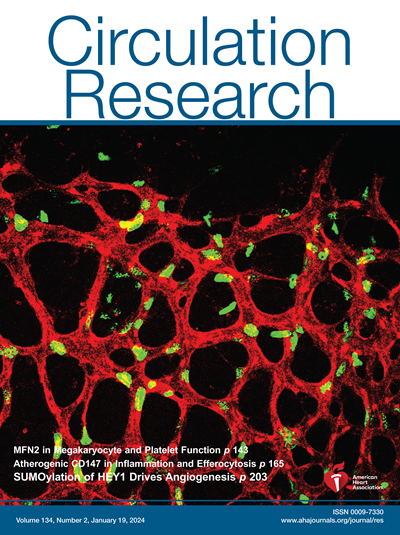Overload of Neprilysin in Placental Extracellular Vesicles Disrupts CNP-NPRB-Mediated Communication Between Vascular Endothelial and Smooth Muscle Cells: A Trigger for Symptoms of Preeclampsia.
IF 16.5
1区 医学
Q1 CARDIAC & CARDIOVASCULAR SYSTEMS
引用次数: 0
Abstract
BACKGROUND Preeclampsia is a placenta-origin pregnancy complication. Although its development has long been divided into 2 stages: abnormal placentation (stage I) and the release of factors from the hypoperfused placenta into circulation, triggering preeclampsia due to endothelial dysfunction (stage II), the placenta-derived substances coupling the 2 stages remain unclear. METHODS Extracellular vesicles (EVs) from normal and preeclampsia-complicated placentas were intravenously administered to pregnant mice, and blood pressure was recorded throughout pregnancy. The differential cargo, including NEP (neprilysin), of placental EVs in normal and preeclamptic placentas was identified by LC-MS, and the cell types involved in NEP expression in the placenta were determined by single-cell RNA sequencing. The effects of placental EVs and recombinant mouse NEP on the uterine arteries were assessed by myography. Placenta-specific NEP overexpression mice were established by in situ injection of adenovirus. The binding affinity between NEP and the vasodilative peptides was determined using an Octet instrument. NEP-overexpressing HUVECs were established to measure CNP (C-type natriuretic peptide) release and cocultured with NPRB (natriuretic peptide receptor-B) knockdown vascular smooth muscle cells (VSMCs) to measure cGMP production in VSMCs. RESULTS Placental EVs from preeclamptic pregnancies impaired vascular endothelium-dependent vasodilation and induced preeclampsia in mice. NEP was expressed predominantly by syncytiotrophoblasts and upregulated in placental EVs from preeclamptic pregnancies. Recombinant mouse NEP administration resulted in outcomes like those of administration of placental EVs from preeclamptic pregnancies. Placenta-specific NEP overexpression disturbed maternal hemodynamics, resulting in hypertension and proteinuria of the mice. CNP exhibited high binding affinity for NEP, and NEP upregulation in HUVECs inhibited CNP release, which further influenced the production of cGMP in VSMCs; however, this effect was largely blunted in NPRB-deficient VSMCs. CONCLUSIONS Excessive NEP in placental EVs from preeclamptic pregnancies is transported into the endothelial cells of uterine and placental arteries to cleave and degrade CNP, resulting in compromised CNP paracrine activity and NPRB-mediated cGMP production in adjacent VSMCs and triggering the hypertensive manifestation of preeclampsia.胎盘细胞外囊泡中奈普利素超载破坏血管内皮细胞和平滑肌细胞之间cnp - nprb介导的通讯:子痫前期症状的触发因素
背景:子痫前期是一种胎盘源性妊娠并发症。虽然其发展长期以来被分为两个阶段:胎盘异常(I期)和低灌注胎盘释放因子进入循环,因内皮功能障碍引发子痫前期(II期),但耦合这两个阶段的胎盘源性物质尚不清楚。方法将正常胎盘和子痫前期胎盘的细胞囊泡(EVs)静脉注射给妊娠小鼠,并记录妊娠期间的血压。通过LC-MS鉴定正常胎盘和子痫前期胎盘EVs的差异货物,包括NEP (neprilysin),并通过单细胞RNA测序确定胎盘中参与NEP表达的细胞类型。采用肌图法观察胎盘EVs和重组小鼠NEP对子宫动脉的影响。通过原位注射腺病毒建立胎盘特异性NEP过表达小鼠。用Octet仪器测定NEP与血管扩张肽的结合亲和力。构建过表达nep的HUVECs用于检测CNP (c型利钠肽)的释放,并与NPRB(利钠肽受体- b)敲低的血管平滑肌细胞(VSMCs)共培养,检测VSMCs中cGMP的产生。结果子痫前期妊娠胎盘EVs损害小鼠血管内皮依赖性血管舒张,诱发子痫前期。NEP主要在合胞滋养细胞中表达,在子痫前期胎盘EVs中表达上调。重组小鼠给予NEP的结果与给予子痫前期妊娠胎盘EVs的结果相似。胎盘特异性NEP过表达扰乱母体血流动力学,导致小鼠高血压和蛋白尿。CNP对NEP具有较高的结合亲和力,HUVECs中NEP的上调抑制了CNP的释放,进而影响了VSMCs中cGMP的产生;然而,在缺乏nprb的VSMCs中,这种作用在很大程度上减弱了。结论子痫前期胎盘EVs中过量的NEP被转运到子宫和胎盘动脉内皮细胞中裂解和降解CNP,导致相邻VSMCs中CNP旁分泌活性和nprb介导的cGMP产生降低,引发子痫前期高血压表现。
本文章由计算机程序翻译,如有差异,请以英文原文为准。
求助全文
约1分钟内获得全文
求助全文
来源期刊

Circulation research
医学-外周血管病
CiteScore
29.60
自引率
2.00%
发文量
535
审稿时长
3-6 weeks
期刊介绍:
Circulation Research is a peer-reviewed journal that serves as a forum for the highest quality research in basic cardiovascular biology. The journal publishes studies that utilize state-of-the-art approaches to investigate mechanisms of human disease, as well as translational and clinical research that provide fundamental insights into the basis of disease and the mechanism of therapies.
Circulation Research has a broad audience that includes clinical and academic cardiologists, basic cardiovascular scientists, physiologists, cellular and molecular biologists, and cardiovascular pharmacologists. The journal aims to advance the understanding of cardiovascular biology and disease by disseminating cutting-edge research to these diverse communities.
In terms of indexing, Circulation Research is included in several prominent scientific databases, including BIOSIS, CAB Abstracts, Chemical Abstracts, Current Contents, EMBASE, and MEDLINE. This ensures that the journal's articles are easily discoverable and accessible to researchers in the field.
Overall, Circulation Research is a reputable publication that attracts high-quality research and provides a platform for the dissemination of important findings in basic cardiovascular biology and its translational and clinical applications.
 求助内容:
求助内容: 应助结果提醒方式:
应助结果提醒方式:


